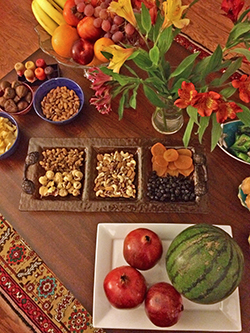Carrying New Year’s Traditions into 2015
International students at Duke share their New Year’s holiday traditions

When some students fly or drive home over the holidays, others stay stateside, sharing cultural and family traditions of their home countries with campus friends.
Duke is a second home for about 3,129 full-time international students who represent more than 110 countries, from Albania to Zimbabwe. New Year’s to many of these students fall on a different part of the calendar, such as Chinese New Year in February or Persian New Year in March.Annette Moore, program coordinator for the International House, Duke’s source of cross-cultural programming and advocacy for the university’s international population, said student organizations help bring traditional dishes, songs and dances to students living in Durham throughout the year. Campus events such as Springternational, Duke’s cultural fair in April, give students a chance to share holiday customs. “It’s helping them navigate how they can keep their traditions while living here,” Moore said. “For a lot of international students, it could be their first time away from home.”On behalf of the New Year, international students shared their country’s traditions:The Coin in the Cake in SerbiaDuke law student Tamara Momirov gets to ring in the New Year twice.For the first round of celebrations, on Dec. 31, Momirov spends the evening with friends in Republic Square, the city center of Belgrade, Serbia, where she grew up. Fireworks go off at midnight above the crowd, much like they would in New York City’s Times Square.Then on Jan. 13, Momirov spends Serbian New Year’s Eve with her family. She visits her grandparent’s house, where her family drinks rakia, a fruit brandy, and eats prebranac, a dish of baked beans. One of her favorite traditions is when her grandmother bakes a cake with a 1920s Serbian coin inside. Whoever finds the coin receives good luck for the new year.Last year, Momirov was submitting college applications, including one to Duke, at the time cake slices were passed out. Her aunt’s friend found the coin and shared it with her. “Obviously, even half of luck was enough for me, since I’m here,” she said.Dolls and Costumes in Ecuador

Maria Cristina Ramos helped make a life-size doll replica of her longtime friend, Elizabeth, for New Year’s a few years ago.Ramos, a Duke Ph.D. sociology student, and friends stuffed the doll with sawdust and gave it similar red hair. Around midnight, the doll was burned, which is supposed to bring good luck to the real person.In Ecuador, these dolls line the streets before midnight on New Year’s Eve. Ramos describes the scene as “madness,” when the streets are filled with people wearing costumes and dancing. After family members give each other advice for the new year, families will carry travel bags and run around the neighborhood exactly at midnight, which is supposed to bring future travels. “I really miss that a lot,” Ramos said. “You really feel like you’re being supported. You really receive a lot of good energy.”Poems and Red Fruit in Iran

On Dec. 21, Farnaz Nojavan and her family will visit her grandparents’ house in northwestern Iran and partake in a spread of nuts and fruit. The red color of the fruit symbolizes sunlight, morning and winter coming to an end.Iran does not officially celebrate the Jan. 1 New Year, said Nojavan, a Duke alumna and Ph.D. graduate in environmental sciences and policy. Instead, Iranians commemorate the longest night during the Winter Solstice, called Yalda. While she studied at Duke, Nojavan spent Yalda with Iranian students and staff. They gathered together on campus, enjoyed fruit and read the works of Hafez, a famous Iranian poet. “We tried to keep all the traditions and do everything that if we were in Iran, we would do, but this time we’re celebrating with friends rather than family,” she said.